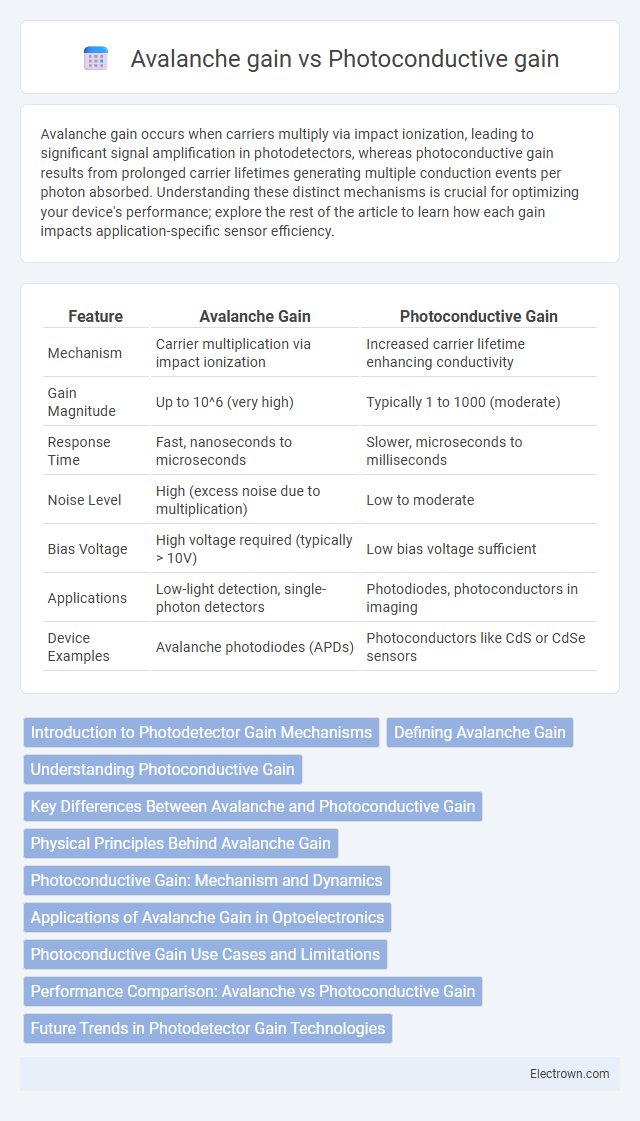Avalanche gain occurs when carriers multiply via impact ionization, leading to significant signal amplification in photodetectors, whereas photoconductive gain results from prolonged carrier lifetimes generating multiple conduction events per photon absorbed. Understanding these distinct mechanisms is crucial for optimizing your device's performance; explore the rest of the article to learn how each gain impacts application-specific sensor efficiency.
Table of Comparison
| Feature | Avalanche Gain | Photoconductive Gain |
|---|---|---|
| Mechanism | Carrier multiplication via impact ionization | Increased carrier lifetime enhancing conductivity |
| Gain Magnitude | Up to 10^6 (very high) | Typically 1 to 1000 (moderate) |
| Response Time | Fast, nanoseconds to microseconds | Slower, microseconds to milliseconds |
| Noise Level | High (excess noise due to multiplication) | Low to moderate |
| Bias Voltage | High voltage required (typically > 10V) | Low bias voltage sufficient |
| Applications | Low-light detection, single-photon detectors | Photodiodes, photoconductors in imaging |
| Device Examples | Avalanche photodiodes (APDs) | Photoconductors like CdS or CdSe sensors |
Introduction to Photodetector Gain Mechanisms
Photodetector gain mechanisms amplify the electrical signal generated by incoming photons, enhancing device sensitivity. Avalanche gain relies on impact ionization within a high electric field, producing multiple charge carriers per absorbed photon, while photoconductive gain arises from prolonged carrier lifetime allowing multiple conduction events per photon. Your choice between avalanche gain and photoconductive gain depends on factors like response speed, noise performance, and application-specific sensitivity requirements.
Defining Avalanche Gain
Avalanche gain refers to the amplification of photocurrent generated in a photodetector through impact ionization, where a single photon creates multiple electron-hole pairs. This process significantly increases the sensitivity of devices like avalanche photodiodes compared to standard photoconductive gain, which relies solely on carrier lifetime and mobility without impact ionization. Understanding avalanche gain is crucial for optimizing your photodetector's performance in low-light or high-speed applications.
Understanding Photoconductive Gain
Photoconductive gain refers to the ratio of the number of charge carriers collected to the number of photons absorbed, highlighting the efficiency of a photodetector in converting light into an electrical signal. Unlike avalanche gain, which relies on impact ionization to amplify current, photoconductive gain arises from prolonged carrier lifetime and carrier mobility, enabling multiple charges to be collected per photon absorbed. Understanding photoconductive gain is crucial for optimizing photodetector sensitivity and response time in applications requiring low noise and high quantum efficiency.
Key Differences Between Avalanche and Photoconductive Gain
Avalanche gain occurs when a photodetector multiplies the number of charge carriers through impact ionization, resulting in higher sensitivity and faster response times compared to photoconductive gain, which relies on prolonged carrier lifetime for signal amplification. Avalanche photodiodes deliver gains typically ranging from 10 to 1,000, while photoconductive gain is usually limited to less than 100 due to recombination processes. Your choice depends on application needs: avalanche gain suits high-speed, low-light detection, whereas photoconductive gain offers simplicity and lower noise for moderate-speed applications.
Physical Principles Behind Avalanche Gain
Avalanche gain occurs when incoming photons generate electron-hole pairs that accelerate under a strong electric field, causing impact ionization and a chain reaction of carrier multiplication, significantly amplifying the photocurrent. Photoconductive gain, in contrast, relies on prolonged carrier lifetimes leading to multiple charge carrier circulations before recombination, thus increasing the detected current without carrier multiplication. Understanding these physical mechanisms helps you optimize photodetector design for enhanced sensitivity and faster response times.
Photoconductive Gain: Mechanism and Dynamics
Photoconductive gain arises from the extended lifetime of photogenerated carriers relative to their transit time, enabling multiple charge carriers to be collected per absorbed photon and thereby amplifying the photocurrent. This gain mechanism relies on carrier trapping and slow recombination processes that prolong carrier presence in the conduction band, resulting in increased conductivity under illumination. Unlike avalanche gain, which involves impact ionization and carrier multiplication under high electric fields, photoconductive gain depends on material properties such as trap density, carrier mobility, and recombination rates to modulate its magnitude and dynamic response.
Applications of Avalanche Gain in Optoelectronics
Avalanche gain enhances photodetector sensitivity by multiplying the photocurrent through impact ionization, enabling highly efficient detection in low-light environments. This phenomenon is crucial in optoelectronic applications such as LIDAR systems, optical communication, and advanced imaging, where rapid and accurate signal amplification is essential. Your devices benefit from avalanche gain by achieving superior performance in photon-starved scenarios compared to conventional photoconductive gain mechanisms.
Photoconductive Gain Use Cases and Limitations
Photoconductive gain is widely used in photodetectors for imaging and optical communication due to its ability to amplify weak optical signals by increasing carrier lifetime relative to transit time. It enables high sensitivity detection but is limited by slower response times and increased noise compared to avalanche gain, which uses impact ionization for internal multiplication. Photoconductive gain is ideal for applications requiring moderate gain with simpler device structures, whereas its limitations make it less suitable for ultrafast or extremely low-light environments.
Performance Comparison: Avalanche vs Photoconductive Gain
Avalanche gain in photodetectors provides significantly higher internal signal amplification compared to photoconductive gain, resulting in improved sensitivity and faster response times. Avalanche photodiodes exhibit lower noise-equivalent power (NEP) and enhanced signal-to-noise ratio (SNR) due to impact ionization multiplication, whereas photoconductive devices rely on carrier lifetime extension, often leading to slower speed and higher dark current. The choice between avalanche and photoconductive gain depends on application requirements for speed, noise performance, and operating voltage.
Future Trends in Photodetector Gain Technologies
Future trends in photodetector gain technologies emphasize enhancing Avalanche gain through improved semiconductor materials like silicon carbide and gallium nitride, which offer higher breakdown voltages and faster response times compared to traditional silicon-based devices. Photoconductive gain advancements focus on nanostructured materials such as perovskites and quantum dots, enabling higher sensitivity and lower noise at room temperature. Your choice between Avalanche gain and Photoconductive gain devices will increasingly depend on application-specific requirements like speed, gain magnitude, and spectral range.
Avalanche gain vs Photoconductive gain Infographic

 electrown.com
electrown.com